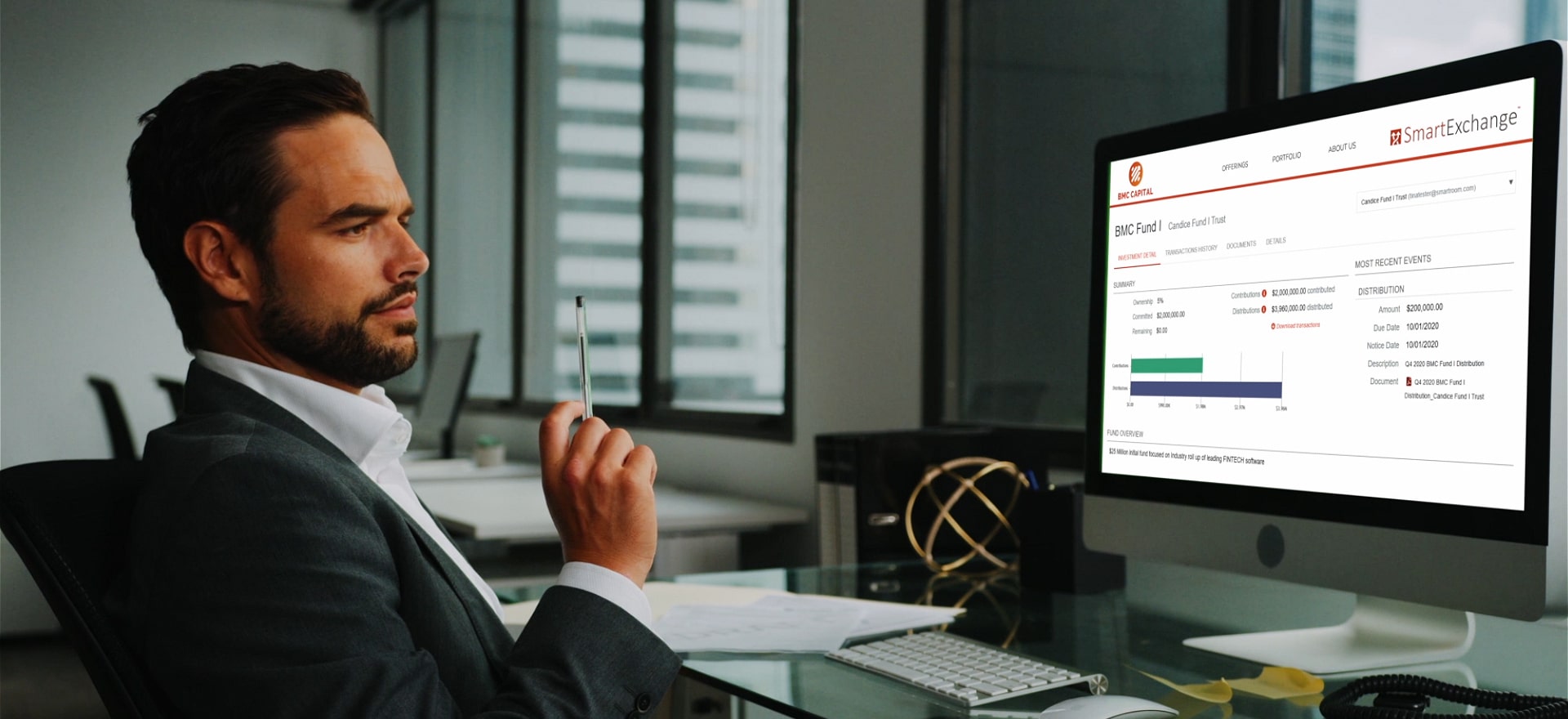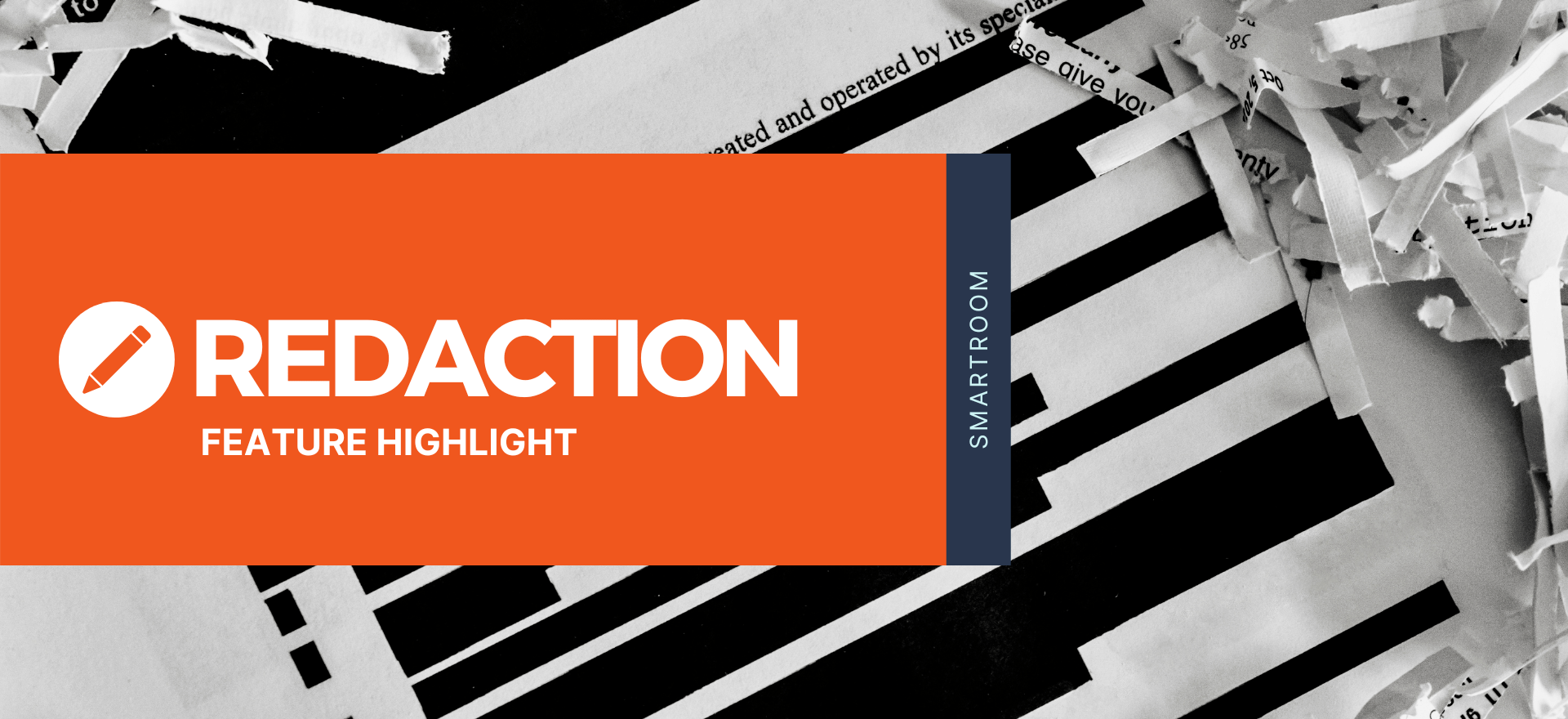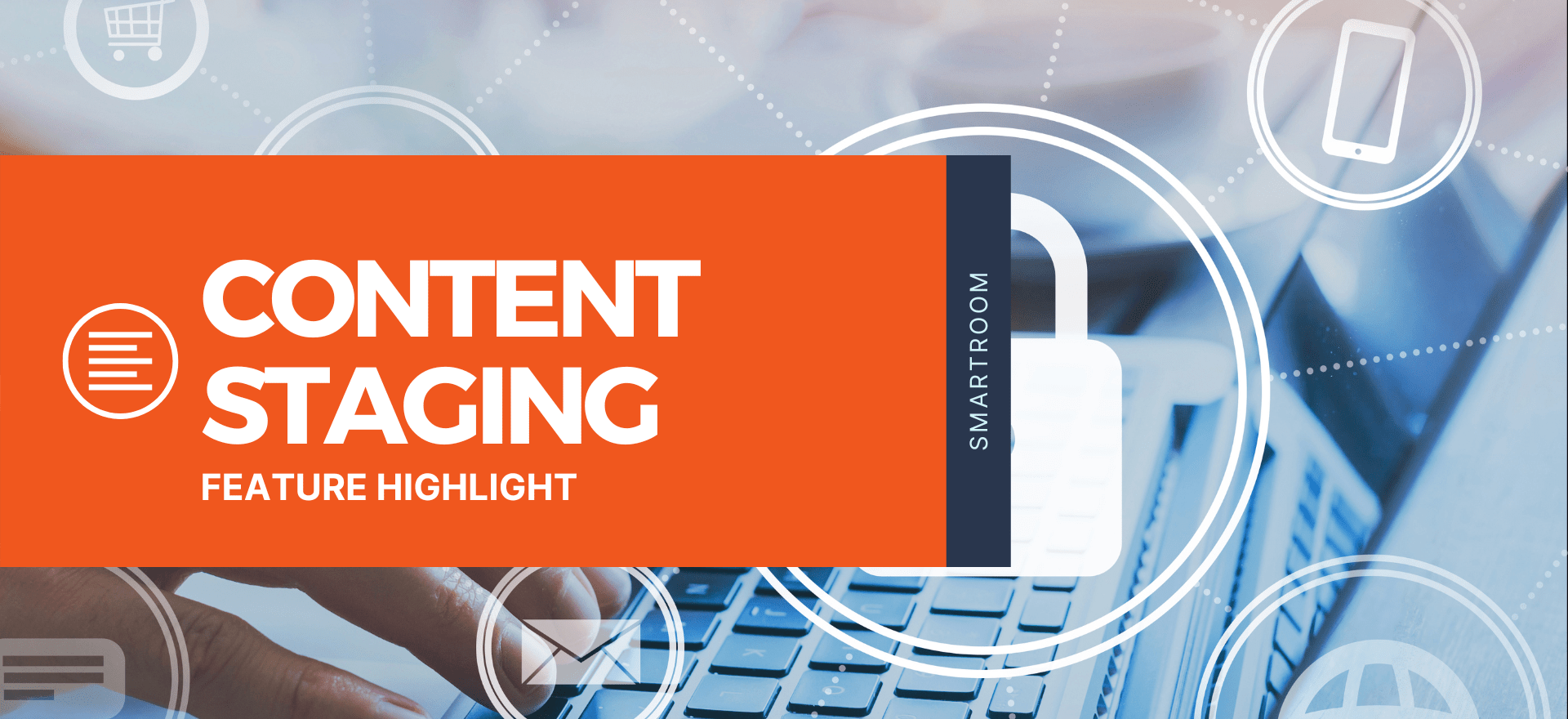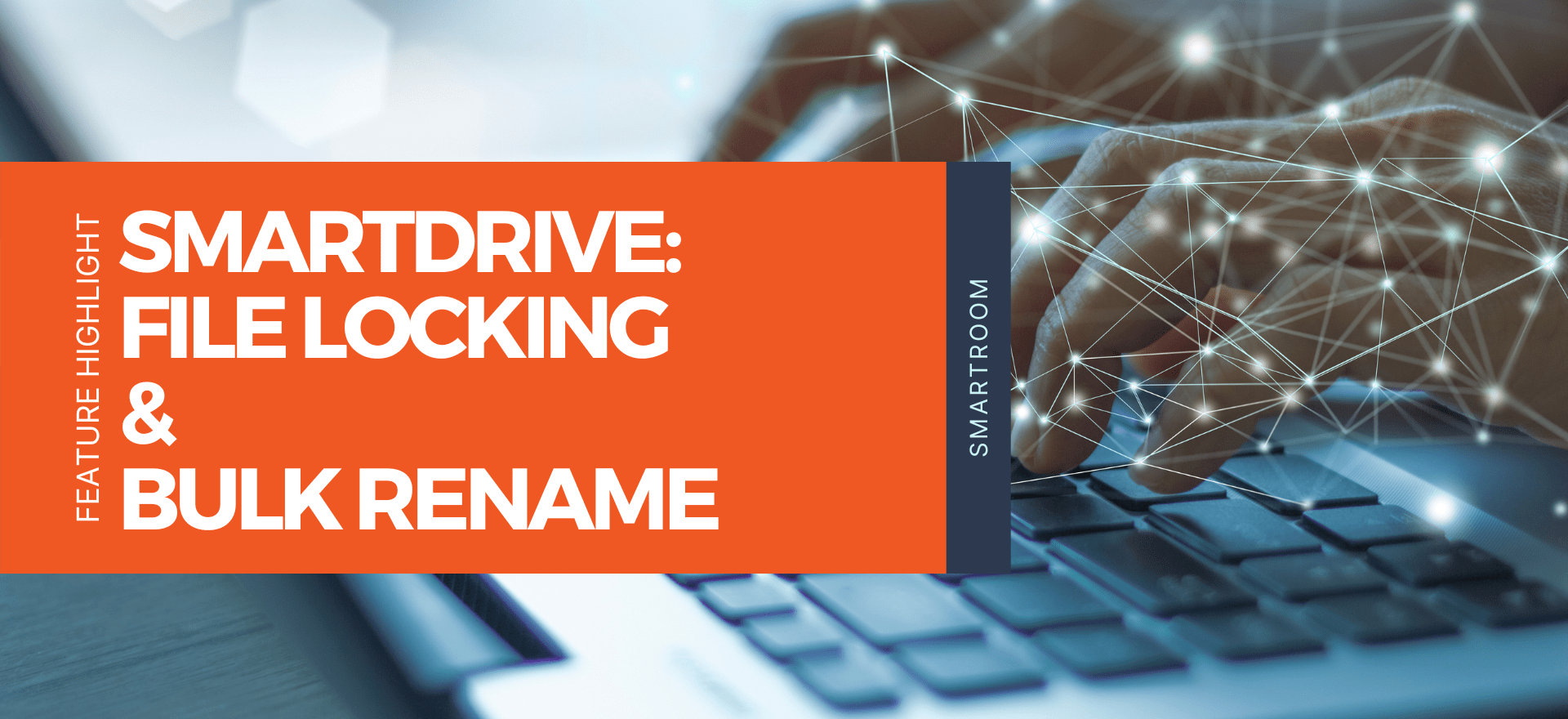by Marko Rojnica | Jun 16, 2022 | Latest News
Hello valued clients and prospective clients!
2022 is halfway over and deal flow continues to be gaining momentum across various industries. Here at SmartRoom, we continue to see an increased demand in deal flow coupled with requests for technology solutions that will help solve real business problems while keeping deal professionals engaged.
We spent the first half of 2022 enhancing our current product offering and introducing new solutions that are focused on streamlining workflow and increasing productivity. Many of these important improvements have led to a wide range of use cases, the signing of new client logos, and increasing usage with our current customers. Additionally, we continue to make significant progress within our restructuring and claims management services.
We’ve also introduced our new SmartExchange platform which has helped alternative investment firms across the country improve investor transparency by providing investors real-time access to reports and dashboards they need most.
Here’s a quick view of what the teams at SmartRoom are delivering for our customers and our continued technology journey.
The SmartRoom Team!
SmartExchange for Alternative Investments
From fundraising marketing and investor reporting to portfolio exits, SmartExchange integrates every stage of a fund’s lifecycle into a single platform, creating a streamlined experience for both fund managers and investors alike.
SmartExchange for Deal Management
SmartExchange integrates project management, file sharing (VDR), CRM, and visual analytics onto one platform. From initial strategy and due diligence to integration planning, all deal processes can be consolidated into one location – creating a single source of truth.
SmartExchange + DealCloud Integration
The SmartExchange + DealCloud integration allows partners to automate all investor relations services in a single platform with real-time information and dynamic reporting. Accessible anytime, anywhere, keeping teams informed and aligned.
SmartRoom Feature: Redaction Tool
Not only is document redaction tedious and time-consuming, but managing information manually or across various 3rd party tools also increases the risk of exposure to sensitive information. SmartRoom’s Redaction Tool solves that problem.
SmartRoom Feature: Content Staging
Content Stages is a flexible and powerful feature that provides an additional layer of security access (called stages) to be set above the modify/view/print/save rights of the security profile.
SmartRoom Feature: File Locking & Bulk Rename
Gain the ability to “lock” a file for editing by selecting the amount of time you want the file to be locked.
Gain the ability to rename files in bulk. This simple & convenient feature has been one of the most requested features that helps your team optimize productivity.
If you have any questions or inquiries regarding our industry-leading platforms SmartRoom & SmartExchange, feel free to contact us at [email protected].
Best,
The SmartRoom Team

by Gina Vlosky | Sep 9, 2020 | Latest News
By: Steve Lumer, SmartRoom Director of Sales and Business Development
It’s been a little over a month since I’ve joined SmartRoom, and one of the things I’ve learned is how we are helping many organizations with various use cases beyond sharing data for M&A and ABS sales.
As COVID-19 continues to affect the way business is conducted, SmartRoom can help. Not only can we empower your dealmakers to remain productive, we can also help your broader enterprise securely access, share, and manage content from any device. Our products and services are helping organizations across all industries with various use cases like the ones below.
- Education – SmartRoom is enabling one of the world’s largest universities to share education material with students so continued education can occur and professors can track which students are reviewing course materials.
- Audits – A large financial institution is conducting ongoing stress testing to ensure their balance sheets are in order. SmartRoom enables them to seamlessly share information with regulators.
- Corporate File Sharing – SmartRoom is assisting a large manufacturing facility with ad-hoc content sharing as their FTP portal has failed them.
- Restructuring & Claims Management – A leading energy firm is turning to us to assist with information sharing during a restructuring process & possible claims management.
- Structured Finance Transactions – A leading asset manager is sharing due diligence materials for a cross-border transaction because deal teams can’t currently be in one location.
- Investor Reporting – Private Equity firms rely on SmartRoom to share investor specific content and overall market summaries.
SmartRoom is so much more than just a virtual data room. I’d love to schedule time in the next coming weeks to learn a little more about your current information sharing workflows and see if SmartRoom can help.
Steve Lumer
[email protected]
917-533-0942

by Gina Vlosky | Jun 22, 2020 | Latest News, Private Equity

Embed This Infographic
Copy and paste the code below to get this infographic onto your website or blog.
CURRENT CONDITIONS
In spite of the incremental steps that have been taken in recent years to improve conditions, there continues to remain a large disparity between standard types of investing and private equity. Investors who place their dollars in a mutual fund, for example, are readily able to access information on every charge that they incur. There is no mystery when it comes to management and performance fees, which is in marked contrast to what private equity investors still experience.
This lack of transparency is evident in several ways. For one thing, access to information from online sources remains unavailable to a wide swath of investors. For many, data is only distributed once per year in the form of the annual report. This situation is made worse by the fact that over half of the country’s private equity companies have not yet come up with a strategy to effectively manage their data.
LPS VS. GPS: DIVERGING PATHS
Limited partners (LPs) are the external investors who contribute their capital into one or more of the funds that the firm handles. This type of structure is not designed for everyone; in fact, investors usually need to shell out at least $250,000 to participate. For that reason, many LPs are not individuals but instead may be foundations, university endowments, pension funds and the like. LPs are only liable for the amount they contribute to the fund, which is managed by the general partner.
Since LPs do not have a direct relationship with their invested monies, it stands to reason that these individuals and companies desire as much transparency in reporting as possible from the general partner who is responsible for managing them. When investors can get their hands on these valuable details on an on-demand basis, they are in a much better position to evaluate the general partner’s performance.
More than a third of LPs choose to have additional control over their funds with customized portfolio exposures. There are several types:
- Security constraints concern conditions that dictate which specific funds cannot be bought or sold and which are held or replaced. These conditions help to match client personal preferences, facilitate balanced portfolios and counterbalance various types of risk;
- Sector constraints help to determine whether funds should always or never be put into certain industries or types of companies;
- Social criteria or restrictions prevent investment in companies of which the client does not approve for religious, ethical or other reasons;
- Minimum or maximum amounts of cash to be invested.
In addition to these customizable features, almost three-quarters of all LPs want the GP with whom they work to be much more open about the types of fees they charge as well as the reasons for each.
General partners want to please the LPs they already have on board and attract more. They also understand that investors are not only demanding more information but are using it to shape the decisions they make. Therefore, it comes as no surprise that 20 percent of the survey respondents list enhanced investor reporting as an important emerging priority.
When today’s savvy LPs do not get the portfolio-related information they want in their desired amount or frequency, they tend to take matters into their own hands. In fact, more than half of the surveyed GPs report that their clients are starting to ask for the data necessary to create their own reports. As a result, general partners are being stretched in new ways, forced by the demands of LPs to find new technological vehicles to provide the information that is being requested.
This trend for requesting added transparency from GPs appears to be increasing in strength and urgency. Only a quarter of the LPs surveyed are happy with the status quo in this arena, a marked drop from the 67 percent of satisfied investors recorded in the past questionnaire.
THE PATH FORWARD
While Excel addresses basic data analysis and management needs, it falls short of the mark for the complex environment of private equity. Limitations include the following:
- Collaboration is difficult;
- Security is minimal;
- Multiple versions of documents can exist;
- Files can be easily corrupted, and it can be difficult to track who made the mistake;
- Instability;
- Difficulty in integrating data;
- Access constraints;
- Issues in creating comprehensive reports;
- Program is dated and clumsy.
It is far better for firms to integrate all of their information through the use of private equity or venture capital software that is suited to the particular needs and constraints of this specialized industry.
For either in-house or out-sourced reporting, portal technology aids in facilitating maximum transparency, security, reliability and visibility for LPs who want real-time access to their data. It provides information about fund performance, residuals, contributions and distributions directly from their funds’ official records. Thanks to this technology and office portfolio management software, they can expect flawless data visualization, access to underlying data in real time, performance reporting and secure delivery of documents.
Private equity firms are repositories for a vast store of data for their investors. Now that LPs are asking for enhanced access to this information, the challenge for firms lies in coming up with technological and communication strategies that will facilitate easy, real-time sharing of specifics about their granular underlying data.
When general partners take actions to meet investors’ requests for enhanced information about their data, positive results ensue. Internal rates of return are more than 10 percent higher, and return on investment (ROI) is increased for the majority of private equity firms who took the leap to use advanced investor service technology. Clients who are already benefiting from customized portfolios anticipate that they will invest additional funds with the private equity firm that has gone the extra mile to give them the specific reports and funding strategies that they request.
THE JOURNEY AHEAD
The Adopting Data Standards (ADS) Initiative consists of a network of private capital stakeholders. Their goals include the following:
- Coming up with a live, GP-LP proof-of-concept for reporting;
- Building consensus and promoting reporting efficiency and consistency;
- Arriving at a set of standards that are accepted worldwide;
- Fostering industry-wide engagement and participation in a “commercially neutral” initiative.
Thanks to this collaboration, a foundation of efficiency and transparency can be fostered among all of the stakeholders in the process.

by Gina Vlosky | May 7, 2020 | Education, Latest News

Embed This Infographic
Copy and paste the code below to get this infographic onto your website or blog.
Scholars at all levels have benefited from the insights and intuitive leaps that come when they work with others. Scientific journals and libraries are just two examples of the fruits of these types of partnerships that have brought about advances in learning throughout the ages. Recently, advanced technology has further revolutionized almost every aspect of the modern secondary and post-secondary learning experience. Thanks to open-source software and commonly available educational resources, faculty and students alike are benefiting in numerous ways.
Learning Management System Solutions
Today’s Learning Management Systems (LMS) are web-based solutions that enable students and faculty to share and collaborate on information of all types; either when they are physically together in the same room or from locations around the globe. Once given the proper authorization credentials, pupils and teachers have 24/7 access to all of the resources contained in the Learning Management System. The system also provides other enhancements, which includes recording all sessions and allowing the administrator/teacher to track individual student progress. Considering these assets, it is no wonder that LMS solutions are being embraced by not only corporations and other businesses, but also educational institutions eager to further their reach and effectiveness.
Despite the many complex features offered by LMS solutions, most faculty have been slow to incorporate them into their daily routines. The majority of staff members who choose to limit the reach of their LMS by only using it to disseminate necessary class information are not taking advantage of the full capabilities of the LMS.
The Role of The Internet & Smartphones in Education
In addition to the robust suite of software that drives the LMS, educators need to keep in mind the tools that students literally hold in their own hands when entering the physical or virtual classroom. Even the lowest-end smartphone can provide a person with access to the infinite information contained online. Instead of being intimidated by the sheer magnitude of this body of knowledge, today’s cutting-edge educator is given the privilege of teaching the essential skill of critical reasoning that can be used to filter, sort through, and refine this data into new and innovative forms. If almost one-third of today’s tech-savvy students are not given the opportunity to use their own equipment in this pursuit and only a quarter are encouraged to harness the power of their smartphones, their entire learning experience could suffer.
The internet has become much more than an entertainment medium. With just a click, students can peruse a world-renown text, consult a direct manufacturer, or collaborate with peers. Instead of answers taking hours or days to be found, they appear almost instantaneously. It is no wonder that pupils are now spending a majority of their daily screen time on the thing that matters most to them: getting their homework done.
Incorporating a LMS into Higher Education
Like students, colleges and universities have firm priorities. However, many do not seem to place their own operating efficiency at the top of their to-do lists. As a result, they are falling behind the technology curve and failing to grasp the benefits that LMS solutions offer. When less than 28% of an educational institution’s crucial faculty members do not have access to these systems (and are not trained in their use), everyone involved feels the effects. The bottom line is a loss of productivity, loss of efficiency for the teacher, loss of the ability to learn effectively for the student, and a loss of enhanced credentials and peer reviews for the university.
There are also over 10% of faculty members who, while having the benefits of LMS solutions at their fingertips, choose not to utilize them. Most likely, intimidation and a reluctance to change comfortable methodologies are the two main factors contributing to this obstinate failure to adapt with the times. However, the train of collaborative education and information sharing has already left the station, and those who do not jump on may find themselves quickly behind.
Students are not immune to the charms of this new learning style. In fact, the majority adamantly want their instructors to take advantage of the innovative learning tools. These include dynamic, web-based supplemental content that makes the learning experience more direct and personal, and lecture capture capabilities that enable an instructor to record presentations and provide ongoing access to the accompanying visual aids long after the actual class session has ended. Considering that the ongoing mission of any good instructor is to keep their students fully engaged and actively learning, it only makes sense to utilize these powerful technological tools to attract and retain scholars/ interest. The fact that 78% of them find that these innovations are invaluable in enabling them to complete their work successfully is a further testament to why they are gaining popularity so quickly in today’s educational milieu.
Blending The Classroom Experience with Technology
That being said, the real power of online interactions comes when an institution can blend them with a traditional classroom experience. 82% of students find that they learn best when the advantages of the internet are combined with good, old-fashioned interaction with an instructor. Even though pupils might have a smartphone in one hand and a mouse in the other, they still value the one-on-one discourse and feedback that can only be found in the traditional learning environment.
Of course, the internet is only as good as the quality of the tools used to access it. Fortunately 68% of colleges and universities seem to have gotten at least part of this equation right. Students, for the most part, find logging into campus WiFi to be reliable. However, the same cannot be said about the actual WiFi performance. In order for seamless learning to take place, this lapse of infrastructure must be addressed by IT specialists, either third-party or within the educational institutions themselves.
Using Collaborative Technology Tools in Learning
Without a doubt, teachers are becoming aware of the importance of incorporating technology into their methodologies. Well over half of them openly encourage students to use collaborative tools to enhance their understanding of concepts. 61%, a slightly higher number, are practicing what they preach by also bringing technology into their own lectures and presentations. As a result, the materials they cover in class can be enriched with audio and visual enhancements, which can deliver a much more engaging lecture.
Now that both faculty and students are, to varying degrees, coming to see the importance of LMS in their academic lives, the results are beginning to show: 40% of young people point to their LMS as being a positive force in improving their ability to collaborate and study with their peers. Also, over half of the teachers have concluded that their LMS is providing a valuable interface between themselves and their students.
SmartRoom for Education
SmartRoom is a content management platform for education that allows administration, faculty, and students to securely share and collaborate on research, course work, and other institutional information. Built with all members of the educational community in mind, SmartRoom doesn’t compromise between security and usability. Every feature has been thoughtfully designed to simplify and accelerate knowledge sharing, while ensuring information remains in the institution’s control. Click here for more information.

by Gina Vlosky | Mar 19, 2020 | Latest News
Dealmakers all over the globe are in the process of trying to determine the markets impact to their current and future deals. As you are seeing from various sources, certain sectors are impacted more than others. If history is an indicator, we know the markets will rebound stronger than ever before!
Our products and services are helping organizations with various use cases like the ones below. Not only can we help your dealmakers remain productive, we can also help your broader enterprise securely access, share, and manage content from any device. As work continues, our online platform can empower people to do their jobs, reduce delays in the deal process, or assist with general information sharing.
Companies Turning to SmartRoom
- SmartRoom is enabling one of the world’s largest Universities to share education material with students so continued education can occur and professors can track which students are reviewing course materials.
- A large financial institution is conducting ongoing stress testing to ensure their balance sheets are in order. SmartRoom enables them to seamlessly share information with regulators.
- A leading energy firm is turning to us to assist with information sharing during a restructuring process & possible claims management
- SmartRoom is assisting a large manufacturing facility with ad-hoc content sharing as their FTP portal has failed them
- A leading asset manager is sharing diligence materials for for a cross-border transaction because deal teams can’t currently be in one location
- Private Equity firms continue to rely on SmartRoom to share investor specific content and overall market summaries
Let us help you. These are uncertain times, but we are committed to helping companies move work forward. As organizations confront unprecedented challenges, they will need to find new ways to work. We’re here to help you find ways to adapt, and support you with the tools you need to come out ahead.
-Pat Schnepf
SmartRoom – Vice President of Sales

by Gina Vlosky | Mar 12, 2020 | Latest News, virtual data rooms
COVID-19 has already disrupted work for millions around the world. Major companies such as Twitter, Google, Microsoft, Amazon, and Facebook have all instructed employees to work remotely, and it’s likely many more will follow suit within the coming weeks now that the World Health Organization has officially declared the outbreak a Pandemic.
Keeping employees healthy and productive should be your top priorities, so it is important to start planning how your company might respond should there be a more widespread outbreak. That plan should include what systems you’ll need to support remote work. If you don’t currently have tools in place, now is the time to start evaluating solutions. Whatever technology you choose, it’s vital it both connects AND protects employees and data.
When choosing a content management and collaboration platform, it’s important you chose a solution built specifically for the enterprise. Platforms like SmartRoom enables employees to securely share and collaborate on content both internally and externally – from anywhere. Unlike consumer file sharing tools, SmartRoom’s multi-layered security combines the highest level of encryption and infrastructure protection, ensuring content is secure no matter where it resides.
SmartRoom boasts a number of features that not only ensures maximum data security, but also accelerates productivity in the remote work setting. With SmartRoom, employers can:
Customize security settings to control content accessibility
Having data stored and organized in a centralized platform streamlines content management, but what happens when you need to restrict user or teams’ accessibility to particular documents? With SmartRoom, administrators can create custom security profiles to control any individual, team, or 3rd party’s accessibility. Restrictions include view, print, save, and modify rights right down to the document level.
Enable access to content from the desktop- even while offline
Wireless and network accessibility can be a limitation to working remotely. Employee’s at-home Internet service may not be reliable- something your IT department cannot control. A poor connection can dramatically slow down an employee’s workflow and decrease productivity. SmartRoom addresses this challenge with its desktop application, SmartDrive. Employees can access and work with SmartRoom content from their desktop in native applications, even while offline. Users can edit and collaborate on files without the fear of losing information as file versions are automatically created on every “save” and synced in the cloud once they come back online. Access to content is maintained by SmartRoom security profiles so company are able control of a user’s view, print, save, and modify rights.
Control corporate content from employee owned devices
Many employees work from office desktops and don’t have corporate issued laptops, posing a serious dilemma for companies. Purchasing laptops for employees can be costly and even wasteful if they are not needed long term. On the other hand, allowing employees to work from their own devices is a security disaster waiting to happen. Luckily, SmartLock an information rights application included with SmartRoom, solves this dilemma by extending content security beyond the SmartRoom environment. Employers can control access rights even after documents have been downloaded to personal devices. Administrators can customize security rights to allow or restrict editing, print, copy/paste or screen captures. They can also schedule content expiration dates in advanced or manually revoke access at any time. All user and data activity are tracked and audited, so organizations continue to exercise complete control over information.
Access content on the go from anywhere
Mobile Accessibility is essential to any remote work force. The SmartRoom Mobile app extends the content management experience to employees’ mobile devices so they can securely share and manage content on the go from anywhere. Developed for maximum efficiency, it provides end users secure access to real-time data, as well as allowing administrators the ability to control access rights.
Share & collaborate on content with 3rd Parties
Working remotely eliminates the ability to communicate and collaborate in person – a luxury we often take for granted. Having an easy way to securely share content with teams and 3rd parties in real-time is essential to maintaining productivity. SmartShare allows users to share content through a secure link, while maintaining complete reporting. SmartRoom also offers messaging capabilities that allows teams to collaborate back and forth on content in real-time.
Microsoft Office Online accessibility for all
Microsoft Office applications like Word and Excel are essential to virtually every business, but employees might not have these programs on their personal devices. Fortunately, Office Online is integrated into SmartRoom, so users can create and edit documents within the data room. Changes are saved in real-time, ensuring teams always have the most up-to-date information available.
Don’t wait until it’s too late! With a detailed plan and tools in place, you can be prepared to implement a remote work strategy that has minimal impact on productivity and bottom line.












